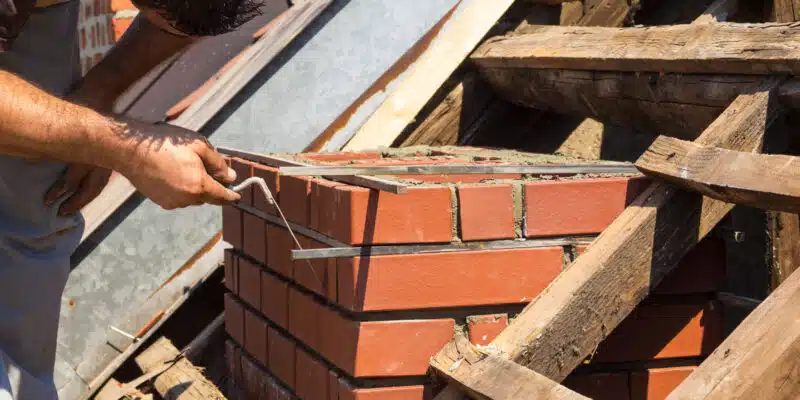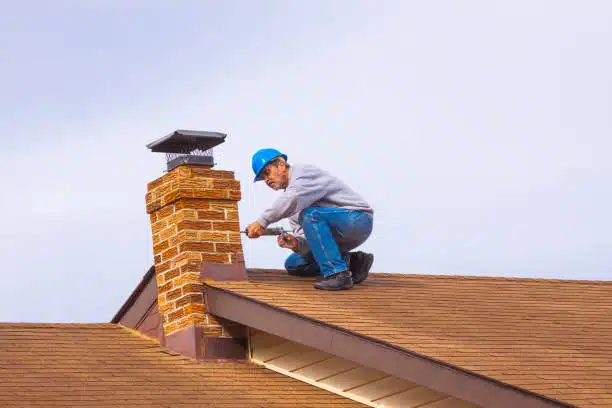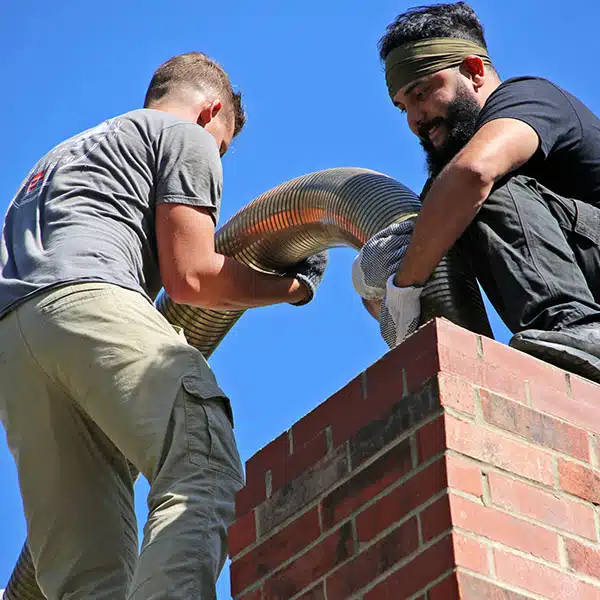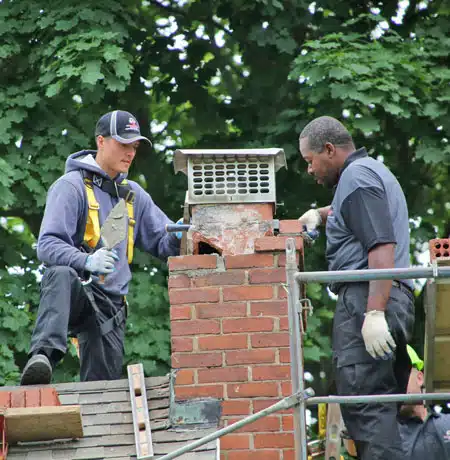If you ever walk past a house that seems to have come right out of Jane Austen or imagine yourself strolling through a countryside lane in Middle Earth, chances are that there might be a stone wall somewhere in there; perhaps pushed up against the side of a hill. This is called a retaining wall.
Like the best things in life, a retaining wall is both pretty and functional. If you have a need or a desire for one in your own landscaping to up the quality of your outdoor aesthetic, knowing more information will always help you to make the best decisions. This guide will help you know exactly what a retaining wall is and how it works, how much a retaining wall will cost, tips and tricks about retaining walls, how a retaining wall will add to your yard, and even some of the best and most creative retaining wall ideas out there!
What is a Retaining Wall and How Does it Work?
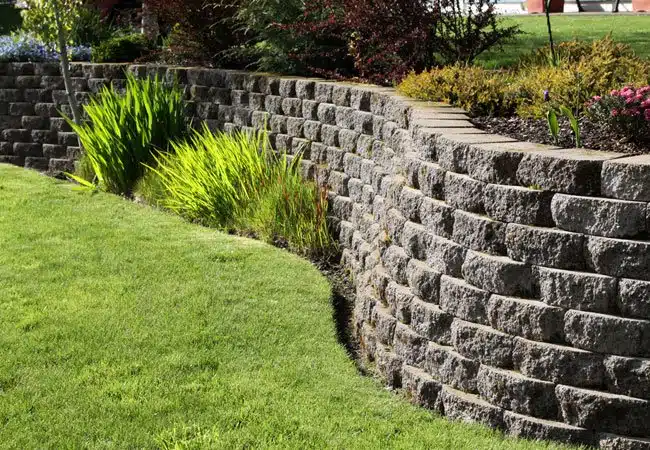
A retaining wall is a wall built of a material solid enough to “retain” (hold in place) dirt and soil behind it. These might be used in a front or back garden, flowerbeds, or any other landscaping structures to ensure that rain, erosion, and other natural issues don’t cause shifts in the soil and a spread or collapse of whatever it is you were trying to keep together.
There are four primary types of retaining walls: gravity retaining walls, reinforced retaining walls, sheet piling retaining walls, and anchored retaining walls.
Gravity Retaining Walls
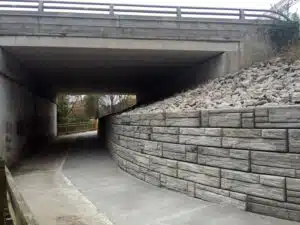
Gravity retaining walls tend to be a little bit shorter in height and rely solely on their own mass (and, ergo, the laws of gravity working with their weight) to keep soil in check. This allows versatility with the materials that can be used when building a gravity wall, and in general, they are a simpler structure to build, with the wall and perhaps a trench or concrete seal at the bottom being the only necessary ingredients.
Reinforced Retaining Walls
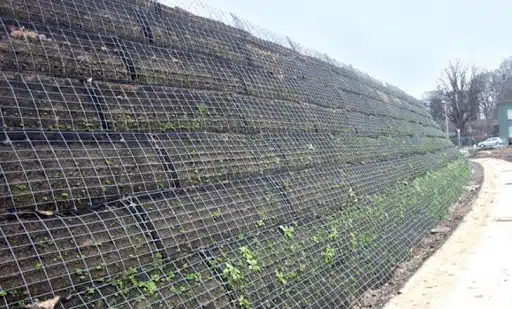
Also known as cantilevered retaining walls, reinforced walls are one of the stronger models because of the foundational support that they exhibit. The wall runs in an L-shape, with the main part being above ground and holding the soil in place, while the shorter part in the form of a slab goes beneath the bed. The weight of the dirt on top of this slab is what keeps it from falling forward. Some reinforced retaining walls have additional structural help in the foundation.
Sheet Piling Retaining Walls

If you have soft soil and are tight on space, a sheet piling wall might be your best bet. Sheet piling walls are just a thin piece of material (usually steel, wood, or vinyl) that is driven into the ground by the soil. Sometimes there is additional support offered with a vertical corrugated structure.
Anchored Retaining Walls
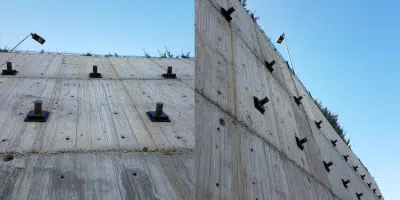
An anchored retaining wall is when anchors are driven into the ground to support the wall, and then they expand while below ground through mechanical or pressurized means from above. Anchored walls can help support any of the other three types of walls, though are most typically used for either large sheet piling walls or a higher load.
Geogrid
Geogrid isn’t a type of retaining wall, but rather a type of material that is helpful for adding to the strength of the wall. It’s a mesh of sorts that acts as a support to the soil that is being kept inside the boundaries. The soil grabs for the geogrid rather than pushing on the wall, and so it alleviates much of the pressure on the stones. Geogrid can be so strong that even sand castles can support concrete when using it!
How Does a Retaining Wall Work?
Essentially, a retaining wall will take a sloping property and help make it functional and beautiful, leveling out certain areas for texture and aesthetic and protecting the yard from the damages of erosion.
Using a variety of materials (stone, brick, wood, concrete, etc.), a retaining wall can even be practical outside of keeping soil in, as it can provide things like outdoor seating or even some privacy if placed correctly.
The materials are stacked or pushed into the ground to create a barrier around the soil bed that they are hemming in, and the soil cannot escape due to the strength of the structure. It makes dangerous land safe (and also makes them ideal for flower beds and gardens!).
It depends primarily on the material that you decide to use (plus labor and parts), but it can cost thousands of dollars to build even one retaining wall. But don’t let that deter you! They have a purpose beyond their beauty, but the fact that they have such an additional aesthetic appeal will add value to your life, and to your home.
Ask your engineer for a price per square foot; on average it is:
- Can $19-$38 for basic concrete blocks.
- Can $18 for brick.
- Up to Can $32 for wood.
- Up to Can $50 for stone or poured concrete.
So now, if you’ve decided that a retaining wall is right for you and your yard, let’s look at some practical tips for what to do – and what not to do – when adding one into your landscaping.
The Do’s and Don’ts of Building a Retaining Wall
It can be exciting to add a new structure to your home! But keep in mind that retaining walls are not only meant to be beautiful but meant to be functional. Here are some tips to keep in mind while making decisions for your retaining wall.
Do Get Help from an Engineer
It might be expensive, but it will be worth it in the long run to have a retaining wall that works. It’s not that you can’t DIY, but installing a retaining wall is more complicated than you might think (especially one taller than four feet) and checking over your plans with a professional could make things much easier.
Do Check Your Materials
Is that geogrid, or snow fence? Are you sure that’s the material you want for your wall? Have you double-checked your measurements? It can save a lot of work, in the long run, to check everything before you make decisions that you can’t go back on.
Do Confirm With Your Local Authorities
You might need permission and permits to build your retaining wall, so know of any potential problems before you begin construction! And don’t start digging before you have checked if there is a pipe or line where you’re planning to make a trench! Call DigSafe for your state to make sure that you don’t have any dangerous complications.
Do Lay Materials Evenly
If you use, say, cinder blocks to make your wall and put the first row on a slope that goes down to the side, you will find yourself laying an entire wall that goes the same direction, which looks messy. If you need to, build tiers of walls rather than one large one, but make sure that the bottom layer of each wall is on even ground!
Your wall should be sloping from top to bottom in a way that leans into the soil it is retaining! Just not from side to side.
Don’t Put Your Wall Near Problematic Roots
The last thing you want is tree roots ruining the structure you’ve just built! A quality foundation is imperative to a good retaining wall, but Mother Nature can disrupt that if you don’t choose a good location to build.
Don’t Forget About Water!
Water is the enemy of all structures. Groundwater can begin to make your wall unstable if you don’t plan for it ahead of time, so it is extremely important to build a drainpipe and gravel or another draining mechanism into your design to account for the flow.
How Installing a Retaining Wall Will Add Beauty to Your Backyard
Retaining walls can be some of the most beautiful pieces in your landscaping if you design it right. Here are some of the primary things to consider when you are thinking aesthetically about your wall.
Materials
The materials you choose should compliment your home, the rest of your yard, and whatever the retaining wall is supporting (garden, flowers, etc.). Below are the most common materials.
Stone is timeless and popular for retaining walls as it adds a more grounded feel to them. Plus, they are lower maintenance than some other materials!
Brick is low maintenance, too, and punctuates a lawn with a very intentional accent. Brick is cozy, clean, and clear – great for bringing attention to your walls!
Concrete is heavy and durable, and while its aesthetic doesn’t fit everywhere, it gives a clean and urban vibe that invites imagination to collaborate with its blank slate.
Finally, wood is a great choice for adding a natural feel to your yard and has a wide variety of options that can match many locations.
In the Soil
Growing something inside your retaining wall will automatically elevate the elegance of your yard. Flowers of any sort will evoke Versailles when you see them peeping over tiers of block stone walls, and even just greenery will be sure to let people know that you are intentional with your choice of decoration.
You can even plant small trees (with non-invasive roots, of course) near (not on) your retaining wall! To have an inviting yard is to tell people that you respect them and yourself, and the land that you live on.
Twenty Cool Ideas for your Retaining Wall
- A brown wood-tiered wall that only grows grass gives a sleek, modern look that almost turns your yard into gigantic steps of a giant. Another great idea for grass retaining walls involves grass-covered steps and gives the impression of a naturally occurring staircase!
- Building a retaining wall around a centerpiece, like a fountain in a courtyard, takes the level of architecture from “pretty” to “dancing-in-Europe-at-sunset-gorgeous.”
- Untreated steel, while not a conventional material, gives almost a post-apocalyptic vibe that can go well with desert homes or a rustic farmhouse. Or try marble for a grandiose display!
- Using huge boulders as your material easily gives the impression of a wall built long ago that has remained standing for centuries. It’s whimsical and impressive at the same time.
- Building benches into your retaining wall gives a romantic feel to the landscape, no matter what material you use!
- Putting a matching in-ground pool into the center of your retaining wall can look and feel like a garden oasis; who wouldn’t love that?
- Making tiers of steps that lead up your wall into a walkway or entrance to your home gives your house the feel of a castle, and gives your guests the experience of walking up to one!
- An intentionally uneven wall with carefully placed plants is the perfect opportunity to have a waterfall running down your retaining wall. Just be sure to have carefully placed pipes to handle it!
- Basic concrete can sound boring, but hand your kid a box of sidewalk chalk and let them get to work changing that blank slate into mural after mural of colorful artwork!
- Draping plants lend a mysterious, Victorian appeal to a retaining wall – especially if it is so concealed by leaves that it looks more like a hedge than rocks!
- Large, flat rocks built as steps into a garden retaining wall are like building stepping stones across a magical pond. In other words, beautiful and desirable.
- You can use shaped stones to create patterns on your wall, like rows of diamonds! It’s eye-catching and eye-keeping.
- A latticed retaining wall, especially a tall one, has the opportunity for many different plants to grow out of it and show a vast vertical garden to your guests!
- If you live in a place with gorgeous natural rock landscaping then you can consider using that to build your retaining wall and blend in with your natural habitat, making it look almost as though your home was raised upright from the ground.
- Multiple high retaining walls can make little pockets of privacy – almost like house rooms in your backyard.
- Multicolored materials make for a vibrant wall that pops out to the eye and brings charm to any yard. You can try making a mosaic with flat stones and lines in between – beautiful!
- Textured material walls – interlocking blocks, overlaying blocks, even using garden planters as part of the wall – are a great choice for anyone looking for an artistic aesthetic that delights the eye!
- Using different materials for one wall (like stone and wood) is a cool way to mix vibes and give a unique flavor to your home.
- Sleepers are materials that are used to keep a structure in place, like the flat railroad tie that supports the other two. Using vertical sleepers can add a very smooth look to your retaining wall, almost as if using a cookie-cutter on your grass!
- Lights. You can add lights to your retaining wall and give it a warm, adventurous look that is great for summer evenings around a grill or fire pit (which you can also build into your retaining wall!)
Retaining walls are beautiful, practical additions to any home, and elevate the quality of life to anyone who experiences them. There is something beautiful about walls, grass, greenery, and flowers all mixed together to preserve soil and preserve elegance. Call your local engineers and landscapers and tell them about your dream retaining wall! They want to help you as much as you want to build it.


